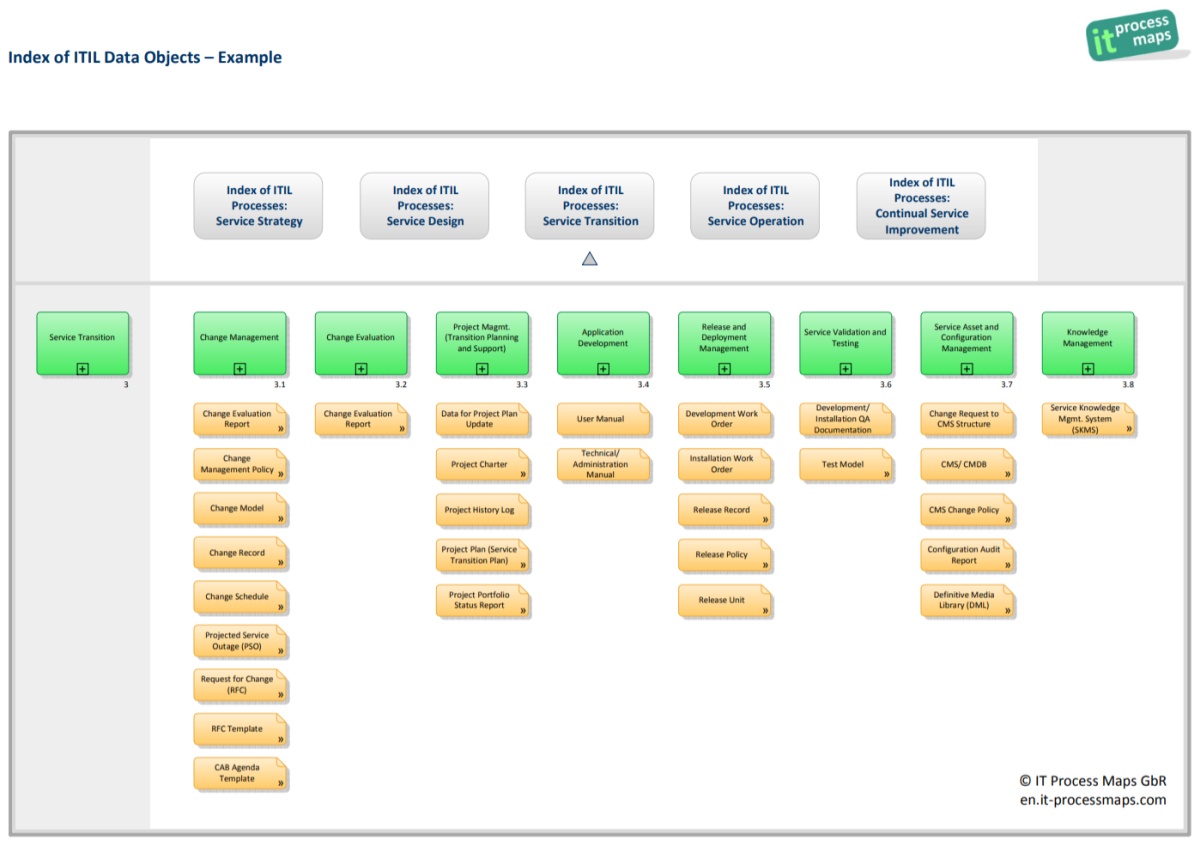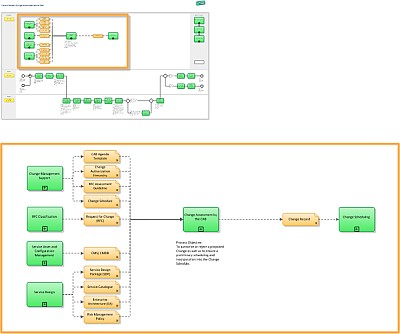ITIL Implementation - Process Interfaces: Difference between revisions
No edit summary |
mNo edit summary |
||
| Line 1: | Line 1: | ||
<seo metakeywords="itil process interfaces, itil interfaces" metadescription="The ITIL Process Map V3 applies a rigorous approach to the definition of interfaces: Information objects may be picked from a central ITIL glossary ..." /> | |||
<imagemap> | |||
Image:ITIL-Wiki-de-es.jpg|DE - ES - ITIL Process Interfaces - ITIL Interfaces|100px | |||
rect 0 0 50 30 [https://wiki.de.it-processmaps.com/index.php/ITIL-Implementierung_-_Prozess-Schnittstellen diese Seite auf Deutsch] | |||
rect 50 0 100 30 [https://wiki.es.it-processmaps.com/index.php/Implementaci%C3%B3n_de_ITIL_-_Interfaces_de_procesos_ITIL esta página en español] | |||
desc none | |||
</imagemap> | |||
<br style="clear:both;"/> | |||
{| | {| | ||
|- | |||
| style="border-bottom:1px solid grey;" |<big><strong> Step 6: Definition of ITIL Process Interfaces </strong></big> | |||
|} | |} | ||
==== Description ==== | |||
The next step determines which inputs each process receives from other processes, and which outputs it must produce so that subsequent processes are able to function. | |||
These inputs and outputs are also called ITIL information objects: Structured sets of data, like e.g. an Incident Record, which serves to describe a Service Request or Service Interruption. | These inputs and outputs are also called ITIL information objects: Structured sets of data, like e.g. an Incident Record, which serves to describe a Service Request or Service Interruption. | ||
| Line 14: | Line 24: | ||
Weaknesses in processes often occur at those points where one process ends and another one begins. In many cases one will find interrupted information flows or media breaks – so that the required information is not exchanged as intended. | Weaknesses in processes often occur at those points where one process ends and another one begins. In many cases one will find interrupted information flows or media breaks – so that the required information is not exchanged as intended. | ||
[[image:Thumb-glossary-itil.jpg|frame|right|alt=ITIL interfaces - ITIL data objects|Figure 1: Index of Data Objects - ITIL V3 Glossary (example)]] | |||
The definition of the process interfaces is taken care of as a separate project step, before dealing with the innards of the processes in detail. Obviously, before being able to define the detailed activities, it must be clear what inputs a process can expect from preceding ones, and which outputs it must produce. | |||
The [https://en.it-processmaps.com/products/itil-process-map.html ITIL Process Map V3] applies a rigorous approach to the definition of interfaces: Information objects may be picked from a central ITIL glossary (see Figure 1) to define the inputs and outputs in a precise way. Every information object contains a short definition to avoid any ambiguities about the expected process results. | |||
A challenge during the definition of the interfaces lies in the fact that, as a rule, not all ITIL processes are introduced at once, which often means that some of the required inputs for a process are missing. | |||
For example, an IT Security Management process could not yet be explicitly defined, but the Service Desk still requires inputs from Security Management, like e.g. Security Alerts. | |||
In order to circumvent this problem, which inevitably springs up during a phased introduction of ITIL, a generic process directory for the IT organization as a whole can be used. | |||
The generic directory offers a structured framework for the definition of process links even if, initially, only a sub-set of the ITIL processes is defined in detail. | |||
Additional ITIL processes can thus be plugged into the process model at a later point in time as needed. | |||
==== Objective of this Project Step ==== | ==== Objective of this Project Step ==== | ||
* Definition of the interfaces for | * Definition of the interfaces for all ITIL processes which are to be introduced | ||
==== Prerequisites ==== | ==== Prerequisites ==== | ||
* Structure of the | * Structure of the [[ITIL Implementation - Process Structure|ITIL processes to be introduced]] | ||
* ITIL information objects ([[ITIL Glossary|ITIL glossary terms]]) as inputs and outputs | |||
* ITIL information objects (ITIL glossary terms) as | |||
==== Results/ Deliverables ==== | ==== Results/ Deliverables ==== | ||
| Line 30: | Line 51: | ||
* Interfaces of the ITIL processes to be introduced: | * Interfaces of the ITIL processes to be introduced: | ||
** with each other | ** with each other | ||
** with other | ** with other ITIL processes | ||
** with | ** with customers and suppliers | ||
==== | ==== Success Factors ==== | ||
* It must be avoided that the newly introduced processes represent an isolated solution; the interfaces to the other processes within the IT organization and beyond it must therefore be considered. | |||
The | * The documentation of the interfaces should be clearly structured, showing details only when required. This calls for overview diagrams showing the big picture and separate detailed interface diagrams for each process. | ||
==== <span style="color:#5d5d5d">Relevant Views of the ITIL Process Map V3</span>==== | |||
[[image:interface_diagram.jpg|frame|right|alt=ITIL interfaces|Figure 2: Detailed process interfaces]] | |||
[[image: | |||
The | <span style="color:#5d5d5d">The [https://en.it-processmaps.com/products/itil-process-map.html ITIL Process Map V3] contains two types of models which, in combination with each other, are used for the definition of the process interfaces:</span> | ||
* <span style="color:#5d5d5d">Process overviews (see [[ITIL Implementation - Process Structure#Relevant Views of the ITIL Process Map V3|Step 5 - Figure 2]]), which illustrate the interrelations of several processes on one single page</span> | |||
* <span style="color:#5d5d5d">Detailed process interface diagrams with all inputs and outputs (see Figure 2)</span> | |||
'''Following Process Activity''': | |||
= | → ITIL Implementation - Step 7: '''[[ITIL Implementation - Process Controlling|Establishing Process Control]]''' | ||
<br style="clear:both;"/> | |||
<!-- This page is assigned to the following categories: --> | |||
[[Category:ITIL V3]][[Category:ITIL implementation]] | |||
<!-- --- --> | |||
Revision as of 12:42, 27 July 2011
<seo metakeywords="itil process interfaces, itil interfaces" metadescription="The ITIL Process Map V3 applies a rigorous approach to the definition of interfaces: Information objects may be picked from a central ITIL glossary ..." />

| Step 6: Definition of ITIL Process Interfaces |
Description
The next step determines which inputs each process receives from other processes, and which outputs it must produce so that subsequent processes are able to function.
These inputs and outputs are also called ITIL information objects: Structured sets of data, like e.g. an Incident Record, which serves to describe a Service Request or Service Interruption.
Just how great the importance of process interfaces is for the design of optimal work procedures frequently becomes apparent during the analysis of as-is Processes:
Weaknesses in processes often occur at those points where one process ends and another one begins. In many cases one will find interrupted information flows or media breaks – so that the required information is not exchanged as intended.

The definition of the process interfaces is taken care of as a separate project step, before dealing with the innards of the processes in detail. Obviously, before being able to define the detailed activities, it must be clear what inputs a process can expect from preceding ones, and which outputs it must produce.
The ITIL Process Map V3 applies a rigorous approach to the definition of interfaces: Information objects may be picked from a central ITIL glossary (see Figure 1) to define the inputs and outputs in a precise way. Every information object contains a short definition to avoid any ambiguities about the expected process results.
A challenge during the definition of the interfaces lies in the fact that, as a rule, not all ITIL processes are introduced at once, which often means that some of the required inputs for a process are missing.
For example, an IT Security Management process could not yet be explicitly defined, but the Service Desk still requires inputs from Security Management, like e.g. Security Alerts.
In order to circumvent this problem, which inevitably springs up during a phased introduction of ITIL, a generic process directory for the IT organization as a whole can be used.
The generic directory offers a structured framework for the definition of process links even if, initially, only a sub-set of the ITIL processes is defined in detail.
Additional ITIL processes can thus be plugged into the process model at a later point in time as needed.
Objective of this Project Step
- Definition of the interfaces for all ITIL processes which are to be introduced
Prerequisites
- Structure of the ITIL processes to be introduced
- ITIL information objects (ITIL glossary terms) as inputs and outputs
Results/ Deliverables
- Interfaces of the ITIL processes to be introduced:
- with each other
- with other ITIL processes
- with customers and suppliers
Success Factors
- It must be avoided that the newly introduced processes represent an isolated solution; the interfaces to the other processes within the IT organization and beyond it must therefore be considered.
- The documentation of the interfaces should be clearly structured, showing details only when required. This calls for overview diagrams showing the big picture and separate detailed interface diagrams for each process.
Relevant Views of the ITIL Process Map V3

The ITIL Process Map V3 contains two types of models which, in combination with each other, are used for the definition of the process interfaces:
- Process overviews (see Step 5 - Figure 2), which illustrate the interrelations of several processes on one single page
- Detailed process interface diagrams with all inputs and outputs (see Figure 2)
Following Process Activity:
→ ITIL Implementation - Step 7: Establishing Process Control






